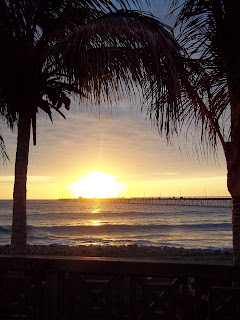Thursday, August 11, 2011
Pacasmayo
As our time in Peru comes to a close, both Ryan and I have felt like taking it easy, so we broke up the trip from Cajamarca to Trujillo with a stop in Pacasmayo. This sleepy beach town was an easy place to pass a few days listening to the ocean and doing as little as possible. We stayed in La Costa Dorada where we had a front-row view of the beach on the top floor of the hotel for a sweet $20.
Highlight: You can walk out onto the longest ( and possibly most rickety) pier in Peru for a cool sol. If you do take this walk, don't bring little kids as there are large chunks of pier missing throughout. Here are a few pics:
Wednesday, August 10, 2011
Cajamarca
We followed our trip to Chiclayo with a six-hour bus ride to Cajamarca, a beautiful mountain city surrounded by hills still sprinkled with gold. It was here that the Spanish killed the last of the Inca Emperors (even after he filled two large rooms with gold to placate them). They did give him one break, however--instead of burning him to death, they only strangled him because he had agreed to convert to Catholicism.
Ryan was coming down with something so we took it easy here, and fortunately, Cajamarca is an easy place to relax. The central plaza is a large, well-maintained affair flanked by stunning churches missing a piece here or there (the Spanish purposely built incomplete churches here to avoid a tax from the monarchy). Here are a few pictures from the area:
Ryan was coming down with something so we took it easy here, and fortunately, Cajamarca is an easy place to relax. The central plaza is a large, well-maintained affair flanked by stunning churches missing a piece here or there (the Spanish purposely built incomplete churches here to avoid a tax from the monarchy). Here are a few pictures from the area:
 |
| View from the local Mirador. It costs one sol to climb to this well-maintained park. Reach it by walking toward the white and blue church on the hill, visible from the central plaza. |
 |
| View #2 from the mirador. |
Tuesday, August 9, 2011
Chiclayo, Sipán, Túcume
 |
| Cathedral in the Plaza de Armas in Chiclayo |
We took a 15-pasenger van (packed, of course, with 24 passengers) out to a vast, dusty site called Tucume. Here we strolled through the 28 adobe pyramids where first the Sican and then the Chimu people once lived. This is another site where excavations and restorations have only just begun, which means that everything is crumbling but also open to roam. These pyramids were in use from about 1000 AD until the Spanish conquest.
If you follow the main trail through the park, you can hike up the hill where the Spanish once executed those who refused to convert by throwing them to their deaths.
In addition to Tucume, we also enjoyed our visit to the museum that is home to the excavations at Sipan--a site where the Moche people buried their dead in the most elaborate of ways. Although museums here are often single rooms filled with broken pots, the Museo Tumbas Reales de Sipan is slick and definitely worth the visit. It's packed with adornments made of gold and precious gems, not to mention the Lord of Sipan himself and the countless others who were buried alongside him. You can visit both the museum and Tucume in the same day via combis. No tours necessary.
 |
| The museum that houses the Lord of Sipan in Lambayeque. Expect long lines. |
Monday, August 1, 2011
Chachapoyas, Kuelap, Gocta, Karija
After a few days in the searing jungle, Ryan and I headed down to the far more temperate city of Chachapoyas via a six- (read nine-) hour bus ride. Chachapoyas, which is the capital of the Department of Amazonas, is a beautiful town tucked high into the cloud forests where the Chachapoyan people faced conquest first by the Incas and then by the Spanish. Although the town itself has a number of well-preserved colonial buildings as well as a slow-paced, friendly atmosphere, the real attractions here are the surrounding landscapes and ruins.
Labels:
Caves,
Chachapoyas,
Gocta,
Karija,
Kuelap,
Ruins,
Waterfalls
Subscribe to:
Posts (Atom)








